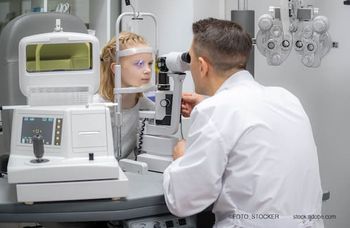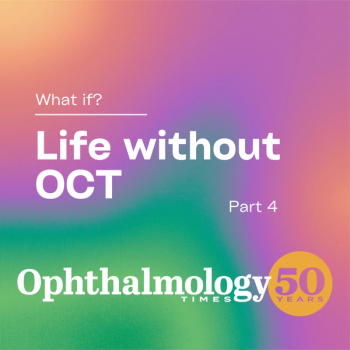
Investigators research ocular health after space flight
Spaceflight-associated neuro-ocular syndrome a potential challenge during long missions.
Ophthalmology continues to play a major role in the characterization and mitigation of one of the highest-priority risks for astronauts during extended spaceflights––spaceflight-associated neuro-ocular syndrome (SANS).
SANS represents the collective neuro-ophthalmic changes found in astronauts who have been exposed to extended periods of microgravity during long-duration spaceflights (LDSFs).
Previously known as visual impairment intracranial pressure (VIIP) syndrome, SANS has a high “likelihood and consequence” rating from the National Aeronautics and Space Administration (NASA), which requires a mitigation plan for missions that range from 1 to 3 years (planetary and deep space habitation.1
Related:
VIIP became known as SANS because of the emerging hypothesis that the condition’s etiology may not stem primarily from intracranial hypertension alone and may, although being possibly multifactorial, require further investigation.1
During LDSF, astronauts are subjected to extended exposure in the microgravity environment, which serves as the primary risk factor for SANS. Approximately 60% of astronauts who underwent LDSF reported a decrease in distance and near visual acuity.1-3
Further, findings from case studies have shown that some astronauts flying on missions longer than 30 days had baseline ocular anatomic changes, which clinicians observed in fundoscopy, orbital ultrasonography,
These neuro-ocular anatomical changes included optic disc edema, hyperopic shift, cotton wool spots, globe flattening, and choroidal folds (Figure 1).2,3,5
The total percentage of study participants with findings of SANS, including optic disc edema, cotton wool spots, choroidal folds, globe flattening, and refractive error, ranges from 37.5% to 51%.1
Related:
Some of these anatomical changes continue to be seen during subsequent postflight follow-ups, and several astronauts have noted that their microgravity-induced refractive errors persist years after their LDSF mission. 4
Our understanding of the specific pathophysiology behind SANS has evolved over time and 2 current theories behind this unique manifestation of neuro-ocular symptoms have emerged.
The first theory stems from the changes in intracranial pressure that arise from cephalad fluid shifts in astronauts.2 Results of studies in transient microgravity have shown a physiological jugular venous distension (JVD), which alludes to possible cerebral and internal jugular venous congestion leading to the intracranial hypertension and subsequent optic disc edema seen in SANS.1
However, the persistence of optic disc edema after astronauts return to Earth, asymmetric disc swelling, and absence of additional clinical findings in intracranial hypertension, such as severe headaches and tinnitus, suggest that increased intracranial pressure may not be the sole underlying cause of SANS.
Related:
In addition, although intracranial pressure readings in astronauts post-LDSF have been elevated, they fall nearly within normal limits and do not reach the expected elevation of pressure that is seen in typical patients with intracranial hypertension.
These findings ultimately suggested that intracranial pressure may not be the sole explanation for SANS and sparked further discussion for the second theory of the condition’s pathophysiology.
The second leading theory hypothesizes that the cerebrospinal fluid (CSF) becomes compartmentalized or “accumulates” inside the optic nerve sheath due to a one-way valve-like system during microgravity.
This CSF compartmentalization results in a heterogenous pressure gradient between the CSF pressure in the optic nerve sheath and the CSF surrounding the brain.
The difference in pressure between these 2 areas could explain the nearly normal intracranial pressure and absence of intracranial hypertension symptoms but extensive disc edema that clinicians see in astronauts.4
The pathogenesis behind SANS continues to be a subject of investigation, and investigators are conducting further studies with astronauts to understand more about SANS’ etiology.
Related:
Currently, astronauts are using different powers of reading glasses (formerly “space anticipation glasses”) that have an increased diopter strength to help mitigate the visual acuity changes when their normal prescription glasses are no longer strong enough to carry out tasks on board the International Space Station (ISS).1
The overall prognosis in astronauts with SANS findings has been variable, but no permanent vision loss has been reported due to LDSF on the ISS.
However, there are reports of persisting choroidal folds years after a mission, as well as hyperopic visual changes that have yet to resolve.2,5
With NASA’s sights set on Mars, continued research into further understanding and mitigating SANS is of the utmost importance for astronaut health and space exploration.
About the authors
Joshua Ong
e: [email protected]
Ong is a medical student at the University of Pittsburgh School of Medicine. Joshua has no financial interests relevant to the subject matter.
Peter Mortensen, MD
e: [email protected]
Mortensen is a Neuro-Ophthalmology Fellow at the Houston Methodist Hospital. Mortensen has no financial interests relevant to the subject matter.
Tyson Brunstetter, OD, PhD
e: [email protected]
Brunstetter is a U.S. Navy Aerospace Optometrist and SANS specialist at the NASA Johnson Space Center in Houston, Texas. Brunstetter has no competing financial interests relevant to the subject matter.
William Tarver, MD
e: [email protected]
Tarver is a flight surgeon and SANS specialist at the NASA Johnson Space Center in Houston, Texas. Tarver has no competing financial interests relevant to the subject matter.
Andrew G. Lee, MD
e: [email protected]
Lee, editor of The Neuro-Connection column, is affiliated with the Blanton Eye Institute, Houston Methodist Hospital. He did not indicate proprietary interest.
References
1. Stenger M.B., Tarver W.J., Brunstetter T.et al. Risk of Spaceflight Associated Neuro-ocular Syndrome (SANS). NASA Human Research Program Human Health Countermeasures Element
2. Mader TH, Gibson CR, Pass AF, Kramer LA, Lee AG, Fogarty J, Tarver WJ, Dervay JP, Hamilton DR, Sargsyan A, Phillips JL, Tran D, Lipsky W, Choi J, Stern C, Kuyumjian R, Polk JD. Optic disc edema, globe flattening, choroidal folds, and hyperopic shifts observed in astronauts after long-duration space flight. Ophthalmology. 2011 Oct;118(10):2058-69. doi: 10.1016/j.ophtha.2011.06.021
3. Mader TH, Gibson CR, Pass AF, Lee AG, Killer HE, Hansen HC, Dervay JP, Barratt MR, Tarver WJ, Sargsyan AE, Kramer LA, Riascos R, Bedi DG, Pettit DR. Optic disc edema in an astronaut after repeat long-duration space flight. J Neuroophthalmol. 2013 Sep;33(3):249-55. doi: 10.1097/WNO.0b013e31829b41a6
4. Lee, A.G., Mader, T.H., Gibson, C.R. et al. Spaceflight associated neuro-ocular syndrome (SANS) and the neuro-ophthalmologic effects of microgravity: a review and an update. npj Microgravity 6, 7 (2020).
5. Mader TH, Gibson CR, Otto CA, Sargsyan AE, Miller NR, Subramanian PS, Hart SF, Lipsky W, Patel NB, Lee AG. Persistent Asymmetric Optic Disc Swelling After Long-Duration Space Flight: Implications for Pathogenesis. J Neuroophthalmol. 2017 Jun;37(2):133-139. doi: 10.1097/WNO.0000000000000467
Newsletter
Don’t miss out—get Ophthalmology Times updates on the latest clinical advancements and expert interviews, straight to your inbox.



















































.png)


